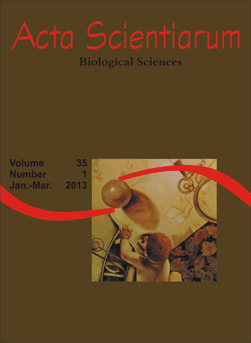<b>Monoculture of the ciliate protozoan <i>Euplotes</i> sp. (Ciliophora; Hypotrichia) fed with different diets</b> - doi: 10.4025/actascibiolsci.v35i1.11795
Resumo
Ciliate protozoa of the genus Euplotes commonly appears contaminating mass cultures of rotifers but also with potential to be used as live food in the larviculture of marine fish. To obtain a monoculture of Euplotes sp., three diets were tested: 1) microalgae Nannochloropsis oculata, 2) commercial diet for rotifers Culture Selco 3000, and 3) baker’s yeast (Saccharomyces cerevisiae). The ciliates were inoculated at 10 ind. mL-¹. On day 5, protozoa densities in the groups fed the commercial diet (1,911.0 ± 248.7 ind. mL-¹) and the baker’s yeast (2,600.0 ± 195.3 ind. mL-1) did not differ, but were higher than the group fed microalgae (2.0 ± 1.4 ind. mL-1) (p < 0.05). On day 6, the density in the group fed baker’s yeast was higher (15,484.0 ± 1,164.9 ind. mL-¹) than in the groups fed microalgae (3.0 ± 1.4 ind. mL-¹) or commercial diet (11,287.0 ± 1,468.0 ind. mL-¹). An exponential growth curve was observed for the protozoa fed baker’s yeast (R² = 0.992; p < 0.05) and commercial diet (R² = 0.979; p < 0.05). The microalgae diet did not result in satisfactory growth of the protozoan. Feeding baker’s yeast or commercial rotifer’s diet to a monoculture of Euplotes sp. can result in very high densities of this protozoan.
Downloads
DECLARAÇÃO DE ORIGINALIDADE E DIREITOS AUTORAIS
Declaro que o presente artigo é original, não tendo sido submetido à publicação em qualquer outro periódico nacional ou internacional, quer seja em parte ou em sua totalidade.
Os direitos autorais pertencem exclusivamente aos autores. Os direitos de licenciamento utilizados pelo periódico é a licença Creative Commons Attribution 4.0 (CC BY 4.0): são permitidos o compartilhamento (cópia e distribuição do material em qualqer meio ou formato) e adaptação (remix, transformação e criação de material a partir do conteúdo assim licenciado para quaisquer fins, inclusive comerciais.
Recomenda-se a leitura desse link para maiores informações sobre o tema: fornecimento de créditos e referências de forma correta, entre outros detalhes cruciais para uso adequado do material licenciado.












1.png)




3.png)













